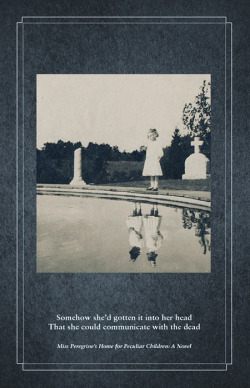I came across Miss Peregrine’s Home for Peculiar Children recently knowing nothing about it – the book’s design is what caught my eye, much in the same way Mark Z. Danielewski’s masterpiece House of Leaves did years ago. House of Leaves, while not being the easiest book to finish, still weighs in as one of my favorites of all time and it was with that book in mind that I picked up and leafed through Miss P’s a couple of weeks ago in the bookstore, marveling at the ingenuity of the design, which by the way is that the story is accompanied (and most definitely enhanced) by a number of antique photographs the author, Ransom Riggs, used from various private collections.
Here’s two of my favorite photos as a taste:


Miss Peregrine’s Home For Peculiar Children is one of those books that you hold in your hand and just the heft and feeling of it, the paper and the images on the cover, combined with a nice combination of smart layout of text and really readable font just begs you to read it. So read it I did.
The first chapter or two I was a little worried. In hindsight this may be because I literally had just put down David Foster Wallace’s The Pale King*, so I was kinda in a whole other zone reading wise. However, Mr. Riggs quickly won me over – the story is expertly paced and plotted, and the characters are fantastic. In a media market where a lot of storytellers are essentially recreating X-Men-type characters, i.e. adolescents with powers, Miss Peregrine’s does not feel derivative at all. Nothing about it feels as though the author simply said, ‘how do I change just enough of the mechanics of the teens-with-powers-thing to make it my own’. Instead the actual story itself comes before the characters. It involves WWII, time travel (of a sort) and the kind of growing pains that some children must go through in order to distance themselves from parents that really aren’t all that effective in the first place as mentors or teachers, and how to deal with losing the adults in their lives who are those things. There’s a nice, rich history that develops here and best of all none of the exposition ever seems forced or spoken at me through another character’s narration, something I’m kinda having trouble now that I’ve finished Miss P’s and moved onto Deborah Harkness’ Discovery of Witches, which I’ve been trying to find time to read for a couple months now, and which comes highly, highly recommended, but is kinda rubbing me the wrong way with the style of narrative exposition.
I’ll let you know how Witches fairs (maybe it’s just another transition from book to book), but for now I’d say if you’re looking for something to read and you’re not put off by ducking into the young adult** section of your favorite bookstore, I’m recommending Miss Peregrine’s.
Oh, and here’s Mr. Riggs’ blog, which I’m also diggin’ : http://www.ransomriggs.com/
………………
* Which, update, is BRILLIANT all the way through. Much of the final seventy or so pages is devoted to an amazingly plain but rabidly insightful conversation in a bar between a kinda plain, boring guy who everyone at the Postal REC which is the major setting for the book calls Mr. X (as in excitement, cuz he’s not) and the one woman in the post who everyman is intimidatingly attracted to. The unbelievable way in which DFW delivers insight into the human condition during this scene (which again, is <60 pages) is remarkable and had me just about as entranced as the final (and also crazy long) scene in Infinite Jest that chronicles one of character Don Gately’s old school drug binges.
** A lot of that section is crap, zom-pire romance wannabe twilight, but then again a lot of stuff in the other sections are crap too. Since the day my wife got me to read Philip Pullman’s His Dark Materials trilogy back somewhere in the ethers of time roundabout ought-three, I’ve kept an open mind about ya. Haven’t found too much else since, but every now and then I do, like Miss P’s now.